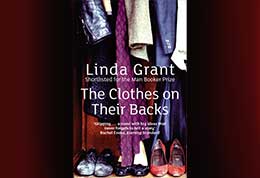In advance of author Linda Grant’s visit to the University of Brighton on 30 November 2015, final year student Sarah-Mary Geissler reflects on the novel she will be discussing – The Clothes on Their Backs* – and its relevance for anyone interested in fashion and dress history.
Every year the University of Brighton participates in The Big Read, a national project to encourage first year students to read a novel that has been nominated for the Booker Prize. This year’s choice is The Clothes on Their Backs (2008) by Linda Grant, an author noted for using dress as a key theme within novels.
As part of my Fashion and Dress History BA, last year I took a module, ‘Reading Dress: 1875-1965’ where literature was examined and considered as a source to research historical dress. During the summer break, our module tutor sent an email regarding The Big Read. She explained that Grant’s novel engaged with the significance of clothing and asked whether we’d like to read the novel over the holidays then meet up for a little book club when we returned to Uni.
I was initially reluctant to take up the request: after spending a whole semester poring over novels intently I wasn’t sure if I could do it again. However, after looking at a review of the novel I was intrigued and had to read it!
The Clothes on Their Backs is an intense novel that delves into the complicated relationships of characters, all of whose clothing defines who they are or think they are. The story accelerates you through the bittersweet moments of life, with elation and tragedy fleeting by and only the ennui of life remaining constant.
The protagonist, Vivien Kovaks, is the daughter of Hungarian immigrants. Her life is spent in and around a small flat in Benson Court. Her parents withhold information about their lives before London and leave Vivien feeling deprived of a family history and heritage. As she later learns, her Uncle Sándor also emigrated to London only to become an infamous slum landlord, heralded as ‘the face of evil’.
Vivien as a person allows herself to be dressed – and therefore defined – by those around her, from her neighbour who leaves her glamourous vintage clothes, to her fiancé who sees her as an upper-class beatnik, to her lover who likes her dressing up in his punk leathers. The clothing of others is embedded in Vivien’s opinions of them, which leads to her fascination with her uncle, a pimp dripping with luxury and ostentation. A theme of what is worn not quite matching up to what is inside the characters runs throughout.
The novel is astoundingly researched, with accurate accounts of 1970s London as well as 1930s Budapest. Even the public reaction to style movements such as the popularity of second-hand clothing to uneasy fears of skinheads and youth gangs were described. Grant captures the incredible spectrum of emotions invested in appearance: Eunice the Jamaican immigrant studies fashion meticulously and goes without food in order to retain an immaculate appearance, while Vivien’s own mother accessorises with homemade waistcoats and a walking stick, not through choice but affliction.
The Clothes on Their Backs is a truly affecting book. Grant creates incredibly three-dimensional characters who are complex, flawed and vulnerable, and contribute to a story that stayed with me long after I’d put the book down.
* First year students at the University of Brighton can collect a free copy of the novel from university libraries, their course leader or the Students’ Union.
